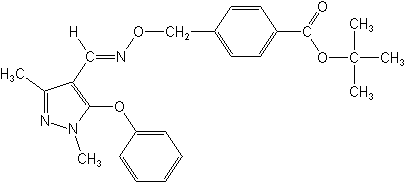-
Common NameFenpyroximate
-
中文通用名唑螨酯
-
IUPACtert-butyl (E)-α-(1,3-dimethyl-5-phenoxypyrazol-4-ylmethyleneaminooxy)-p-toluate
-
CAS1,1-dimethylethyl 4-[[[(E)-[(1,3-dimethyl-5-phenoxy-1H-pyrazol-4-yl)methylene]amino]oxy]methyl]benzoate
-
CAS No.134098-61-6
-
Molecular FormulaC24H27N3O4
-
Molecular Structure
-
Category
-
ActivityAcaricide/Miticide
Fenpyroximate is a contact acaricide for foliar application. It has no translaminar or systemic activity. It exhibits activity against all life stages of mites, but is most active on larvae, nymphs and adults. Lower dose rates are needed for the inhibition of larval molting than are required to achieve effective control of adult populations. The compound has a rapid knockdown effect, within one day of treatment, which therefore suppresses feeding and oviposition. Knockdown is increased with higher temperatures and adult mites may be killed one day after treatment. The compound has residual activity lasting up to one month and may be applied in any season. Nihon Nohyaku recommends one spray per season in resistance management programmes. In the US, no more than two sprays of FujiMite can be made each season, with a maximum usage of 2 pints/acre. The pre-harvest interval is 14 days.
AgrEvo reported trials against insect pests as well as mites (see BBA 1996).
In field trials, fenpyroximate gave equal or better control of target species than commercial standards at lower application rates. The product was safe to all crops tested.
Fenpyroximate has shown no cross-resistance to other classes of acaricide. It has a good margin of safety on beneficials such as carabid beetles, predatory mites (Typhlodromus pyri) and wasps (Ephedrus), green lacewings (Chrysoperla carne), ladybirds, spiders (Pardosa), pirate bugs (Orius spp) or predacious thrips (Scolothripssp).
-
CropUseCropUses:
almonds, apples, apricots, artichokes, aubergines, avocados, bananas, blackberries, blueberries, broad beans, burdock, celery, cherries, chestnuts, chicory, citrus, cotton, cranberries, cucumbers, cucurbits, dates, dry beans, endives, gherkins, ginger, gingko nuts, grapefruits, guavas, hops, huckleberries, Japanese pears, Japanese plums, kidney beans, kiwis, legumes, lemons, lettuces, limes, loquats, makuwauri, mangoes, melons, mitsuba, mume pears, natsudaidai, nectarines, okra, oranges, ornamentals, papayas, parsnips, parsley, passion fruit, peaches, peanuts, pears, peas, pecans, persimmon, pimentos, pineapples, plums, pumpkins, quinces, raspberries, salsify, seeds, shungiku, soybeans, spinach, strawberries, tea, tomatoes, unshu oranges, vines, walnuts, watermelons
Apples
2.5-5 g ai/hl
Citrus
2.5-5 g ai/hl
-
PremixSpirotetramat+Fenpyroximate
-
Physical PropertiesMolecular weight:421.5; Physical form:White, crystalline powder. Density:1.25 g/cm3 (20 °C); Composition:Tech. is 97.0%. Melting point:101.1-102.4 °C; Vapour pressure:0.0075 mPa (25 °C); Partition coefficient(n-octanol and water):logP = 5.01 (20 °C); Solubility:In water 1.46 ×10-2 mg/l (20 °C). In methanol 15, acetone 150, dichloromethane 1307, chloroform 1197, tetrahydrofuran 737 (all in g/l, 25 °C).; Stability:Stable in acid and alkali.;
-
ToxicologyOral:Acute oral LD50 for male rats 480, female rats 245 mg/ kg. Percutaneous:Acute percutaneous LD50 for male and female rats >2000 mg/kg. Non-irritating to skin; slightly irritating to eyes (rabbits). Inhalation: LC50 (4 h) for male rats 0.33, female rats 0.36 mg/l. Phytotoxicity:Not phytotoxic to top fruit, citrus, tea, vegetables and ornamentals. ADI:( JMPR) 0.003 mg/ kg b.w. [1994].
-
Environmental Profile
Ecotoxicology:
Bees:No adverse effect on honeybees at 250 ppm (5 recommended dose).Birds: LD50 for bobwhite quail and mallard ducks >2000 mg tech./kg. Dietary LD50 (8 d) for bobwhite quail and mallard ducks >5000 ppm.Daphnia: LC50 (3 h) 0.085 mg/l.Fish: LC50 (48 h) for carp 0.006 mg/l.Other beneficial spp.:Relatively non-toxic to predacious mites. Little adverse effect at 25-50 ppm on Chrysopa nipponensis, Harmonia axyridis, Ephedrus japonicus, Misumenops tricuspidatus, Lycosa pseudoannulata, Orius
Environmental fate:
Soil: DT50 26.3-49.7 d (J. Pestic. Sci., 18, 67-75 (1993)).
Fate in :
In soil and water, the product has two main routes of degradation: photodegradation and microbial degradation. Fenpyroximate is practically non-toxic to birds while it is highly toxic to fish and aquatic invertebrates.Fate in soil:
The half-life of fenpyroximate in the soil is approximately one month. It has weak mobility in the soil, but no tendency to accumulate or migrate. The Koc varies from 7,545 (sand soil) to 58,333 (loam) with an average value of 33,988
Soil photolysis (laboratory) half life is 22 days, similar to the value obtained from field trials (16-31 days).Fate in aquatic systems:
Fenpyroximate has a half-life of 226 days at neutral pH.
The half life in aqueous photolysis studies is 0.5 - 1.5 hours. -
Transport InformationHazard Class:II(Moderately hazardous)
Porduct NewsMore
Orthosulfamuron boosts sugarcane production, study finds
Glyphosate price plummets 40% in one year in Argentina
Indian govt stops imports of herbicide Glufosinate priced below Rs 1,289 per kg
Carbendazim fungicide wins victory in Brazilian Parliament
Corteva presents new pre-emergent herbicide Linear for sugarcane in Brazil
Picloram Triclopyr Aminopyralid
Revolutionizing disease prevention: BASF launches new rice fungicide Cevya® in China
Thiamethoxam is allowed again in Brazil by a judicial decision
Bayer develops alternative to glyphosate herbicide
Related CompaniesMore
Country: India
Zinc phosphide Aluminium phosphide Profenofos Glyphosate Tebuconazole Chlorpyrifos Fluroxypyr Chlorpyrifos+cypermethrin Cypermethrin+profenofos Tebuconazole+Sulphur Sulphur
Shandong Sino-Agri United Biotechnology Co., Ltd.
Country: China
Nitenpyram Pyridaben Imidacloprid Acetamiprid Dicamba Thiacloprid
Country: China
Glufosinate-ammonium Oxadiazon Fipronil Acetamiprid Azoxystrobin Bispyribac-sodium Dimethomorph Oxadiargyl Emamectin benzoate Nitenpyram Spirodiclofen Pyraclostrobin
HPM Chemicals & Fertilizers Ltd.
Country: India

 0
0 Subscribe
Subscribe
